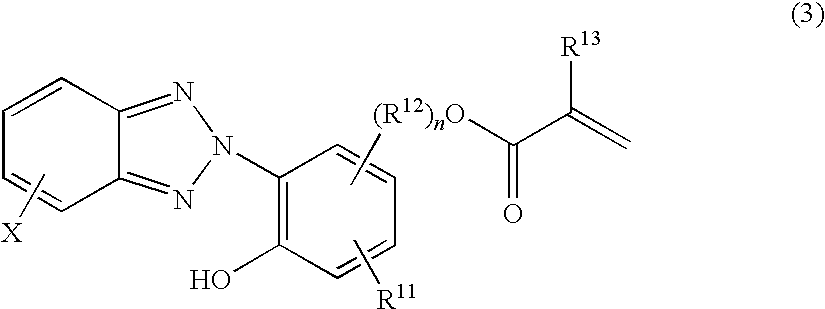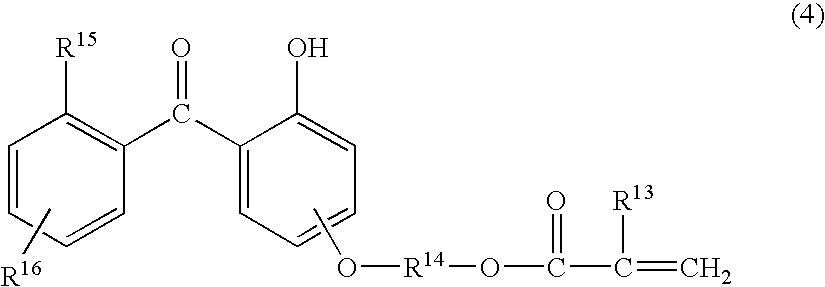Uv-shielding coating composition and coated article
a coating composition and ultraviolet light technology, applied in radiation-absorbing paints, instruments, lighting and heating apparatus, etc., can solve the problems of poor UV resistance and weatherability, adversely affecting the adhesion of the undercoat layer to the underlying substrate, and uv absorber into the undercoat layer, etc., to achieve sufficient UV resistance and durability, and maintain visible light transparency.
- Summary
- Abstract
- Description
- Claims
- Application Information
AI Technical Summary
Benefits of technology
Problems solved by technology
Method used
Image
Examples
synthesis example 1
[0211]A 2-L flask equipped with a stirrer, condenser and thermometer was charged with 152 g of diacetone alcohol as a solvent and heated at 80° C. under a nitrogen stream. To the flask, a 240-g portion of a previously prepared monomer mix solution (containing 67.5 g of 2-[2′-hydroxy-5′-(2-methacryloxyethyl)phenyl]-2H-benzotriazole under the trade name of RUVA-93 from Otsuka Chemical Co., Ltd., 90 g of γ-methacryloxypropyltrimethoxysilane, 270 g of methyl methacrylate, 22.5 g of glycidyl methacrylate, and 350 g of diacetone alcohol), and a 54-g portion of a previously prepared solution of 2.3 g of 2,2′-azobis(2-methylbutyronitrile) as a polymerization initiator in 177.7 g of diacetone alcohol were added in sequence. The solution was allowed to react at 80° C. for 30 minutes, after which the remainder of the monomer mix solution and the remainder of the initiator solution were simultaneously added dropwise at 80-90° C. over 1.5 hours. Stirring continued at 80-90° C. for a further 5 ho...
synthesis example 4
[0214]A 2-L flask equipped with a stirrer, condenser and thermometer was charged with 338 g of methyltrimethoxysilane. With stirring at 20° C., 98 g of water-dispersed colloidal silica (Snowtex O, Nissan Chemical Industries Ltd., average particle size 15-20 nm, SiO2 content 20%) and 230 g of 0.25N acetic acid aqueous solution were added. The mixture was stirred for 3 hours and at 60° C. for a further 3 hours, after which 300 g of cyclohexanone was added. The byproduct methanol was distilled off under atmospheric pressure. Then 300 g of isopropanol and 134 g of a 0.25% isopropanol solution of tetrabutylammonium hydroxide were added. The solution was diluted with isopropanol to a nonvolatile content of 20% (JIS K6833). The organopolysiloxane solution thus obtained had a viscosity of 4.1 mm2 / s and a Mw of 2,500. This organopolysiloxane is designated E-1.
Synthesis of Colloidal Silica-Laden Organopolysiloxane Composition
synthesis example 5
[0215]A 1-L flask equipped with a stirrer, condenser and thermometer was charged with 336 g of methyltriethoxysilane and 94 g of isobutanol. To the solution which was stirred under ice cooling and kept below 5° C., 283 g of water-dispersed colloidal silica (Snowtex 0, Nissan Chemical Industries Ltd., average particle size 15-20 nm, SiO2 content 20%) below 5° C. was added. The mixture was stirred under ice cooling for 3 hours and at 20-25° C. for a further 12 hours, after which 27 g of diacetone alcohol and 50 g of propylene glycol monomethyl ether were added. Then 3 g of a 10% sodium propionate aqueous solution as a curing catalyst and 0.2 g of a polyether-modified silicone KP-341 (Shin-Etsu Chemical Co., Ltd.) as a leveling agent were added, followed by adjustment to pH 6-7 with acetic acid. It was diluted with isobutanol to a nonvolatile content of 20% (JIS K6833) and aged at room temperature for 5 days, yielding a colloidal silica-laden organopolysiloxane composition having a vis...
PUM
| Property | Measurement | Unit |
|---|---|---|
| Fraction | aaaaa | aaaaa |
| Time | aaaaa | aaaaa |
| Percent by mass | aaaaa | aaaaa |
Abstract
Description
Claims
Application Information
 Login to View More
Login to View More - R&D
- Intellectual Property
- Life Sciences
- Materials
- Tech Scout
- Unparalleled Data Quality
- Higher Quality Content
- 60% Fewer Hallucinations
Browse by: Latest US Patents, China's latest patents, Technical Efficacy Thesaurus, Application Domain, Technology Topic, Popular Technical Reports.
© 2025 PatSnap. All rights reserved.Legal|Privacy policy|Modern Slavery Act Transparency Statement|Sitemap|About US| Contact US: help@patsnap.com



